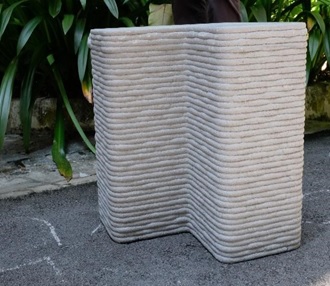Recycled glass waste used in 3D printing
Researchers from Nanyang Technological University, Singapore (NTU Singapore) have developed the capability to use recycled glass in 3D printing, opening doors to a more environmentally sustainable way of building and construction.
Glass is one material that can be 100% recycled with no reduction in quality, yet it is one of the least recycled waste types. Glass is made up of silicon dioxide, or silica, which is a major component of sand, and therefore it offers significant untapped potential to be recycled into other products.
At the same time, due to growing populations, urbanisation and infrastructure development, the world is facing a shortage of sand, with climate scientists calling it one of the greatest sustainability challenges of the 21st century.
For these reasons, the NTU research team is seeking to find ways to recycle glass by 3D printing it into items for everyday use.
One of their innovations published recently in the Journal of Building Engineering, used a specially formulated concrete mix comprising recycled glass, commercial cement products, water, and additives to 3D print a concrete bench. By figuring out the optimal concrete formulation, the NTU research team was able to successfully 3D print a 40cm tall L-shaped bench (see image) as a proof of concept that their material could be 3D printed into an everyday structural (weight-bearing) product.
In lab compression tests and filament quality (strength) tests, the 3D printed structure showed excellent buildability – the printed concrete does not deform or collapse before the concrete cures – and extrudability, meaning the special concrete mix is fluid enough to flow through the hoses and print nozzle.
A new pathway for recycling glass
According to the latest data by the National Environment Agency of Singapore, only 13% of the 74,000 tonnes of glass waste generated in the country was recycled in 2021. Without being fully exploited for other purposes, most of the glass waste finds its way into incinerators before being disposed of in a landfill.
While scientists elsewhere have described the use of glass in concrete mixtures, none of them has been able to successfully 3D print a structure using a glass-based concrete mixture, until now.
The principal investigator of the study Professor Tan Ming Jen of the NTU School of Mechanical and Aerospace Engineering (MAE) said, “The main challenge in formulating 3D-printable concrete mixtures is to figure out just how much of each component to add to obtain a structurally sound structure with minimal defects. Our team has come up with a feasible formula, demonstrating for the first time that glass can indeed be used to 3D-print a bench with excellent structural integrity.”
“The research also exemplifies the concept of a ‘Circular Economy’. 70% of glass is made up of silicon dioxide, or silica. What our research does is to essentially return the silica found in glass to be reused again as sand in our 3D printing concrete mixture,” Prof Tan added.
As a result of the successful proof-of-concept, the NTU research team believes their development offers a new pathway to recycling glass waste and can contribute to a greener building and construction industry for Singapore and beyond.
The new development builds on previous 3D printing for construction research by Prof Tan and his team at NTU’s Singapore Centre for 3D Printing (SC3DP).
The NTU scientist was also behind the 3D printed bathroom project in 2019, where an unfurnished bathroom was printed in 12 hours in Singapore – half the time required for conventional construction of the same facility.
Replacing sand in concrete

As the second most widely used substance after water, concrete relies on sand as a vital ingredient to ensure its durability.
Reports by the United Nations Environment Programme have also revealed that around the world, aggressive sand extraction from rivers has led to pollution, flooding, and other environmental consequences.
First author of the NTU-led study, Andrew Ting, a researcher at the SC3DP said, “Our research has shown that recycled glass can be used to replace up to 100% of the sand in concrete for 3D printing. The result is a concrete bench with a mechanical strength that meets acceptable industrial standards. Given that sand is being exploited at a rate much quicker than it can be replenished naturally, the prospect of using recycled glass in building and construction is becoming more attractive. We believe our development has great potential to relieve the demand on sand for this sector in the future.”
Moreover, as glass is a material that is naturally hydrophobic – meaning it does not absorb water – less water is required to create a concrete mix suitable for 3D printing use.
How the L-shaped bench is 3D printed
Through detailed and extensive analysis and testing, the NTU research team established the optimal parameters for the recycled-glass concrete mixture that would allow it to be 3D-printed.
Components of the mixture include recycled glass crushed to different size classes (Medium, Fine and Superfine), commercial cement product, water, and other additives. To enable printing, the team adjusted the control systems of the 3D printer to match the flow rate of the nozzle to the hardening properties of the concrete.
The printing was then carried out in a single build using a 4-axis gantry robotic printer which has a print volume of 1.2 x 1.2 x 1m. The specially designed concrete mixture was fed to a pumpand transported to a nozzle mounted on the robotic arm, depositing the material layer by layer according to the digital blueprint.
The technology and know-how employed in this research project are protected by a Technology Disclosure filed through NTU’s innovation and enterprise company, NTUitive, and is owned by the university.
Moving forward, the NTU research team, in collaboration with Singapore start-up company Soda Lemon, will look at 3D printing larger scale and more diverse structures using the recycled glass concrete mix, and to optimise the printing algorithm for consistent performance.






